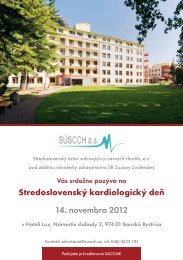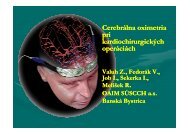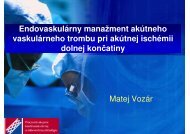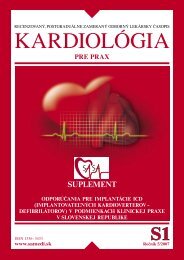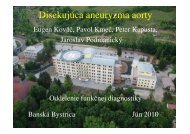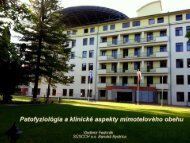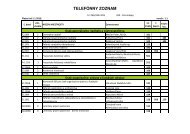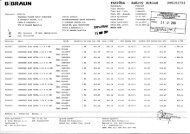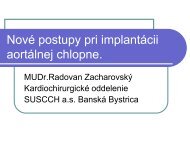Management of acute myocardial infarction in patients presenting ...
Management of acute myocardial infarction in patients presenting ...
Management of acute myocardial infarction in patients presenting ...
You also want an ePaper? Increase the reach of your titles
YUMPU automatically turns print PDFs into web optimized ePapers that Google loves.
ESC Guidel<strong>in</strong>es 2921<br />
and successful resuscitation are no contra<strong>in</strong>dication to fibr<strong>in</strong>olytic<br />
therapy. Fibr<strong>in</strong>olytic therapy should not be given to <strong>patients</strong> refractory<br />
to resuscitation. 73<br />
Readm<strong>in</strong>istration <strong>of</strong> a fibr<strong>in</strong>olytic agent<br />
If there is evidence <strong>of</strong> persistent occlusion, re-occlusion, or re<strong><strong>in</strong>farction</strong><br />
with recurrence <strong>of</strong> ST-segment elevation the patient<br />
should be immediately transferred to a hospital with PCI capabilities.<br />
If rescue PCI is not available, a second adm<strong>in</strong>istration <strong>of</strong> a nonimmunogenic<br />
fibr<strong>in</strong>olytic agent may be considered, if there is a<br />
large <strong>in</strong>farct and if the risk <strong>of</strong> bleed<strong>in</strong>g is not high, 74 although <strong>in</strong><br />
the REACT trial readm<strong>in</strong>istration <strong>of</strong> a fibr<strong>in</strong>olytic agent was not<br />
better than a conservative therapy. 46<br />
Fibr<strong>in</strong>olytic regimens (Tables 8, 9 and 10)<br />
Angiography after fibr<strong>in</strong>olytic therapy (Table 11)<br />
If it is likely that fibr<strong>in</strong>olysis was successful (ST-segment resolution<br />
<strong>of</strong> .50% at 60–90 m<strong>in</strong>, typical reperfusion arrhythmia, disappearance<br />
<strong>of</strong> chest pa<strong>in</strong>) angiography is recommended if there are no<br />
contra<strong>in</strong>dications. In the CARESS trial, a more conservative strategy<br />
with send<strong>in</strong>g <strong>patients</strong> for angiography only <strong>in</strong> the case <strong>of</strong><br />
failed fibr<strong>in</strong>olysis was associated with a worse cl<strong>in</strong>ical outcome<br />
when compared with a strategy <strong>of</strong> referr<strong>in</strong>g all <strong>patients</strong> for angiography<br />
and (if <strong>in</strong>dicated) PCI. 75 In order to avoid an early PCI<br />
dur<strong>in</strong>g the prothrombotic period follow<strong>in</strong>g fibr<strong>in</strong>olysis, on the<br />
one hand, and to m<strong>in</strong>imize the risk <strong>of</strong> reocclusion, on the other<br />
hand, a time w<strong>in</strong>dow <strong>of</strong> 3–24 h follow<strong>in</strong>g successful fibr<strong>in</strong>olysis<br />
16,76 – 78<br />
is recommended.<br />
Adjunctive anticoagulant and antiplatelet therapy (Tables 5, 9 and 10)<br />
Conv<strong>in</strong>c<strong>in</strong>g evidence <strong>of</strong> the effectiveness <strong>of</strong> aspir<strong>in</strong> was demonstrated<br />
by the ISIS-2 trial, 79 <strong>in</strong> which the benefits <strong>of</strong> aspir<strong>in</strong> and<br />
streptok<strong>in</strong>ase were additive. The first dose <strong>of</strong> 150–325 mg<br />
should be chewed (no enteric-coated aspir<strong>in</strong> because <strong>of</strong> slow<br />
onset <strong>of</strong> action) and a lower dose (75–100 mg) given orally daily<br />
thereafter. If oral <strong>in</strong>gestion is not possible, aspir<strong>in</strong> can be given<br />
i.v. (250–500 mg). In the CLARITY trial, <strong>patients</strong> 75 years<br />
were treated with a standard fibr<strong>in</strong>olytic regimen and randomized<br />
Table 11 Angiography dur<strong>in</strong>g hospital stay after<br />
fibr<strong>in</strong>olytic therapy and <strong>in</strong> <strong>patients</strong> who did not receive<br />
reperfusion therapy<br />
Recommendations Class a Level b<br />
................................................................................<br />
Evidence <strong>of</strong> failed fibr<strong>in</strong>olysis or uncerta<strong>in</strong>ty about IIa B<br />
success: immediate<br />
Recurrent ischaemia, reocclusion after <strong>in</strong>itial I B<br />
successful fibr<strong>in</strong>olysis: immediate<br />
Evidence <strong>of</strong> successful fibr<strong>in</strong>olysis: with<strong>in</strong> 3–24 h IIa A<br />
after start <strong>of</strong> fibr<strong>in</strong>olytic therapy<br />
In unstable <strong>patients</strong> who did not receive I C<br />
reperfusion therapy: immediate<br />
In stable <strong>patients</strong> who did not receive reperfusion IIb C<br />
therapy: before discharge<br />
a Class <strong>of</strong> recommendation.<br />
b Level <strong>of</strong> evidence.<br />
to 300 mg clopidogrel load<strong>in</strong>g dose followed by 75 mg per day or<br />
placebo on top <strong>of</strong> aspir<strong>in</strong> up to and <strong>in</strong>clud<strong>in</strong>g the day <strong>of</strong> angiography<br />
with a maximum <strong>of</strong> 8 days (mean duration 3 days). By 30 days,<br />
clopidogrel therapy reduced the odds <strong>of</strong> the composite end-po<strong>in</strong>t<br />
<strong>of</strong> death from cardiovascular causes, recurrent <strong>myocardial</strong> <strong><strong>in</strong>farction</strong>,<br />
or recurrent ischaemia, lead<strong>in</strong>g to a reduction <strong>of</strong> the need<br />
for urgent revascularization <strong>of</strong> 20%. The rates <strong>of</strong> major bleed<strong>in</strong>g<br />
and <strong>in</strong>tracranial haemorrhage were similar <strong>in</strong> the two groups. 52<br />
In the COMMIT study, 80 45 852 Ch<strong>in</strong>ese <strong>patients</strong> <strong>of</strong> any age<br />
(but ,1000 <strong>patients</strong> .75 years) with suspected <strong>myocardial</strong> <strong><strong>in</strong>farction</strong><br />
(93% with STEMI) were randomized to clopidogrel 75 mg (no<br />
load<strong>in</strong>g dose) or placebo <strong>in</strong> addition to aspir<strong>in</strong>. Clopidogrel significantly<br />
reduced the odds <strong>of</strong> the composite <strong>of</strong> death, <strong>myocardial</strong><br />
<strong><strong>in</strong>farction</strong>, or stroke, correspond<strong>in</strong>g to n<strong>in</strong>e fewer events per<br />
1000 <strong>patients</strong> treated for 2 weeks. Accord<strong>in</strong>gly, there is a<br />
good case for the rout<strong>in</strong>e use <strong>of</strong> clopidogrel <strong>in</strong> the <strong>acute</strong> phase.<br />
A comb<strong>in</strong>ation <strong>of</strong> half-dose fibr<strong>in</strong>olytic therapy and full-dose<br />
abciximab did not reduce mortality but was associated with an<br />
<strong>in</strong>creased risk <strong>of</strong> bleed<strong>in</strong>g complications, especially <strong>in</strong> elderly<br />
<strong>patients</strong> when compared with full dosis lytic therapy <strong>in</strong> two large<br />
randomized trials. 81,82<br />
Hepar<strong>in</strong> has been extensively used dur<strong>in</strong>g and after fibr<strong>in</strong>olysis,<br />
especially with alteplase. Hepar<strong>in</strong> does not improve immediate clot<br />
lysis, but coronary patency evaluated <strong>in</strong> the hours or days follow<strong>in</strong>g<br />
fibr<strong>in</strong>olytic therapy with alteplase appears to be better with i.v.<br />
hepar<strong>in</strong>. 83 No difference <strong>in</strong> patency was apparent <strong>in</strong> <strong>patients</strong><br />
treated with either s.c. or i.v. hepar<strong>in</strong> and streptok<strong>in</strong>ase. 84 I.v.<br />
hepar<strong>in</strong> adm<strong>in</strong>istration until discharge has not been shown to<br />
prevent reocclusion after angiographically proven successful coronary<br />
fibr<strong>in</strong>olysis. 85 Hepar<strong>in</strong> <strong>in</strong>fusion after fibr<strong>in</strong>olytic therapy<br />
may be discont<strong>in</strong>ued after 24–48 h. Close monitor<strong>in</strong>g <strong>of</strong> i.v.<br />
hepar<strong>in</strong> therapy is mandatory; aPTT values .70 are associated<br />
with higher likelihood <strong>of</strong> mortality, bleed<strong>in</strong>g, and re<strong><strong>in</strong>farction</strong>. 86<br />
A full weight adjustment <strong>of</strong> the hepar<strong>in</strong> dose may decrease the<br />
risk <strong>of</strong> non-cerebral bleed<strong>in</strong>g complications. 82<br />
In the ASSENT-3 trial (n ¼ 6095), a standard dose <strong>of</strong> the<br />
LMWH enoxapar<strong>in</strong> given <strong>in</strong> association with tenecteplase for a<br />
maximum <strong>of</strong> 7 days 82 reduced the risk <strong>of</strong> <strong>in</strong>-hospital re<strong><strong>in</strong>farction</strong><br />
or <strong>in</strong>-hospital refractory ischaemia when compared with hepar<strong>in</strong>.<br />
However, <strong>in</strong> the ASSENT-3 PLUS (n ¼ 1639) trial, 87 pre-hospital<br />
adm<strong>in</strong>istration <strong>of</strong> the same dose <strong>of</strong> enoxapar<strong>in</strong> resulted <strong>in</strong> a significant<br />
<strong>in</strong>crease <strong>in</strong> <strong>in</strong>tracranial haemorrhage rate <strong>in</strong> elderly <strong>patients</strong>. In<br />
the large ExTRACT trial (n ¼ 20 506), a lower dose <strong>of</strong> enoxapar<strong>in</strong><br />
was given to <strong>patients</strong> .75 years and to those with impaired renal<br />
function (estimated creat<strong>in</strong><strong>in</strong>e clearance ,30 mL/m<strong>in</strong>). Enoxapar<strong>in</strong><br />
treatment was associated with a significant reduction <strong>in</strong> the risk <strong>of</strong><br />
death and re<strong><strong>in</strong>farction</strong> at 30 days when compared with a weightadjusted<br />
hepar<strong>in</strong> dose, however at the cost <strong>of</strong> a significant <strong>in</strong>crease<br />
<strong>in</strong> non-cerebral bleed<strong>in</strong>g complications. The net cl<strong>in</strong>ical benefit<br />
(absence <strong>of</strong> death, non-fatal <strong><strong>in</strong>farction</strong>, or <strong>in</strong>tracranial haemorrhage)<br />
favoured enoxapar<strong>in</strong>. Benefit was observed regardless <strong>of</strong><br />
the type <strong>of</strong> fibr<strong>in</strong>olytic agent and the age <strong>of</strong> the patient. 88,89<br />
In the large OASIS-6 trial, a low dose <strong>of</strong> fondapar<strong>in</strong>ux, a synthetic<br />
<strong>in</strong>direct anti-Xa agent, was superior to placebo or hepar<strong>in</strong><br />
<strong>in</strong> prevent<strong>in</strong>g death and re<strong><strong>in</strong>farction</strong> <strong>in</strong> 5436 <strong>patients</strong> who received<br />
fibr<strong>in</strong>olytic therapy. 57 In the subgroup <strong>of</strong> 1021 <strong>patients</strong> <strong>in</strong> whom<br />
concomitant hepar<strong>in</strong> was felt to be <strong>in</strong>dicated, fondapar<strong>in</strong>ux was



